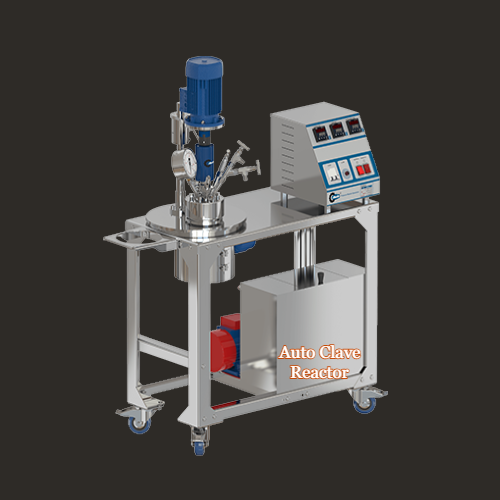High pressure Auto clave reactor
- Home
- Products
- High pressure Auto clave reactor
High Pressure Autoclave Reactor (popular as a polymerization reactor) is a conventional device in the chemical industry that has the primary function of performing mixing procedures for chemical reactions in the liquid phase. A pressure reactor is a chemical reaction vessel that carries out a chemical reaction under high pressure and temperature. Researchers can operate the vessel in batch mode at temperatures ranging from 150 °C to 500 °C. It is manufactured from stainless steel grade 316-L as per the process requirements.
The structure of a High-Pressure Reactor consists of a cylindrical lateral shell with a typical Tori spherical/ Ellipsoidal dish at the top ends. The outer side of the reactor has a jacket for heating and cooling. The surface between the shell and the jacket has Stiffener Rings that provide regular heating or cooling media circulation and increase the vessel’s strength.
The High Pressure Autoclave Reactor assembly is mounted on the top dish of the Batch Reactor. It consists of a lantern assembly on the top end that supports the shaft. This part also contains a bearing housing with a tapered roller to endure impact and vibratory loads. As a result, there is a smooth rotation of the shaft. Shafts can have several agitators such as single anchor, dual anchor, turbine, and propeller. It also contains baffles within the shell as per requirements.
A pressure reactor has various benefits over a standard round-bottom flask. For example, it can perform a reaction above a solvent’s boiling point. Second, pressure can lower the reaction volume, including the liquid phase, increasing concentration and collision frequency while accelerating a reaction. Temperature increases can not only hasten the intended response but also hasten the breakdown of chemicals and starting materials. On the other hand, the pressure might accelerate the desired reaction and only affect decomposition when it includes the release of a gas or interaction with gas in the vessel.

Properties of High Pressure Autoclave Reactor
- Reactors have volumes ranging from 50 mL to 100 liters.
- It has a pressure of up to 350 bars, and temperatures up to 500 °C are possible.
- Material of Construction (MOC) options include SS-316, SS-316L, Hastelloy B/C, Monel, Nickel, Inconel, Titanium, Tantalum lined, and Zirconium.
- Magnetic drive coupling with high torque and negligible leakage
- A fully automated PC-controlled high-pressure system/pilot plant constantly monitors, controls, and records factors such as temperature, pressure, motor speed, gas/liquid flow, level, torque, and so on.
Applications of High Pressure Autoclave Reactor
High-pressure reactors find application in the petroleum and chemical industries, biological medicine, and materials science. Science, geology, chemistry, environmental science, food science, commodities inspection,and so on are all examples.
Polymerization reactors are employed in high-pressure and temperature. These autoclave vessels perform chemical reactions like alkylation, bromination, carboxylation, amination, acetylation, and dehydrogenation. It also has esterification, acylation, catalytic reduction, chlorination, ethoxylation, ozonization, polymerization, halogenation, hydrogenation, methylation, nitration, oxidation, sulphonation, and many more.
How To Use High Pressure Autoclave Reactor
Keep the High-Pressure Reactor together against the gas pressure by tensile load inside the container’s walls. The standard (tensile) stress in the vessel walls of a High Pressure Reactor is dependent on the pressure and diameter of the vessel and indirectly proportional to the thicknesses of the walls. Make sure you use safety measures while performing experiments.
Safety Measures
When operating a high-pressure reactor, researchers must keep the following considerations in mind:
- The high-pressure reaction vessel should be kept in a high-pressure operating room that fulfills explosion protection criteria. The operating room must have a direct connection to the outside or route, and the high pressure reactor must have dependable grounding.
- Researchers need to handle extreme care to avoid any impact and damage. A high-pressure reactor is usually shut with conical contact through the sealing ring. Tighten the main screws to make them dense with one another.
- When installing the cover, install the pressure reaction kettle body and the kettle covers in a fixed position. Install it carefully on the kettle body.
- To produce a good sealing effect, tighten the central bolt diagonally, with a consistent force, and without allowing the kettle lid to tilt to one side.
- Heat and pressure the high pressure reactor before using it. Use Nitrogen as the test medium. The use of oxygen and other flammable and dangerous gases is strictly banned.
- Gently increase the temperature and pressure with a temperature rise rate of less than 80°C/h.
- Connect the autoclave’s air intake valve to the cylinder through the connecting pipe during the pressure test.
- To assess the sealing condition, increase the pressure numerous times, with a 20 percent working pressure interval, persisting for 5 minutes at every rising level and staying for 30 minutes when rising to test pressure. The working pressure is 100 – 105 percent of the experimental pressure.
Products List
- Laboratory Plasticware
- Laboratory Glassware
- Laboratory chemicals
- High pressure autoclaves reactors
- S.S High temp Reactor
- Ball mill
- Hot air oven
- High Temperature Furnaces
- Heating mantle
- Oil bath
- Water bath
- Silicon Carbide Heating Elements(SIC)
- Silicon carbide crucibles
- Hot plate
- Hot plate with magnetic stirrer
- PH meter
- TDS meter
- Graphite Crucibles
- 99% Alumina crucibles ,Boat ,Rod, dish, tray, plate &Tubes etc
- Graphite Rod
- Overhead Stirrers
- Metal Product
- AODD PUMP
- ETP/STP water treatment plant
- Hydraulic Pellet Press
